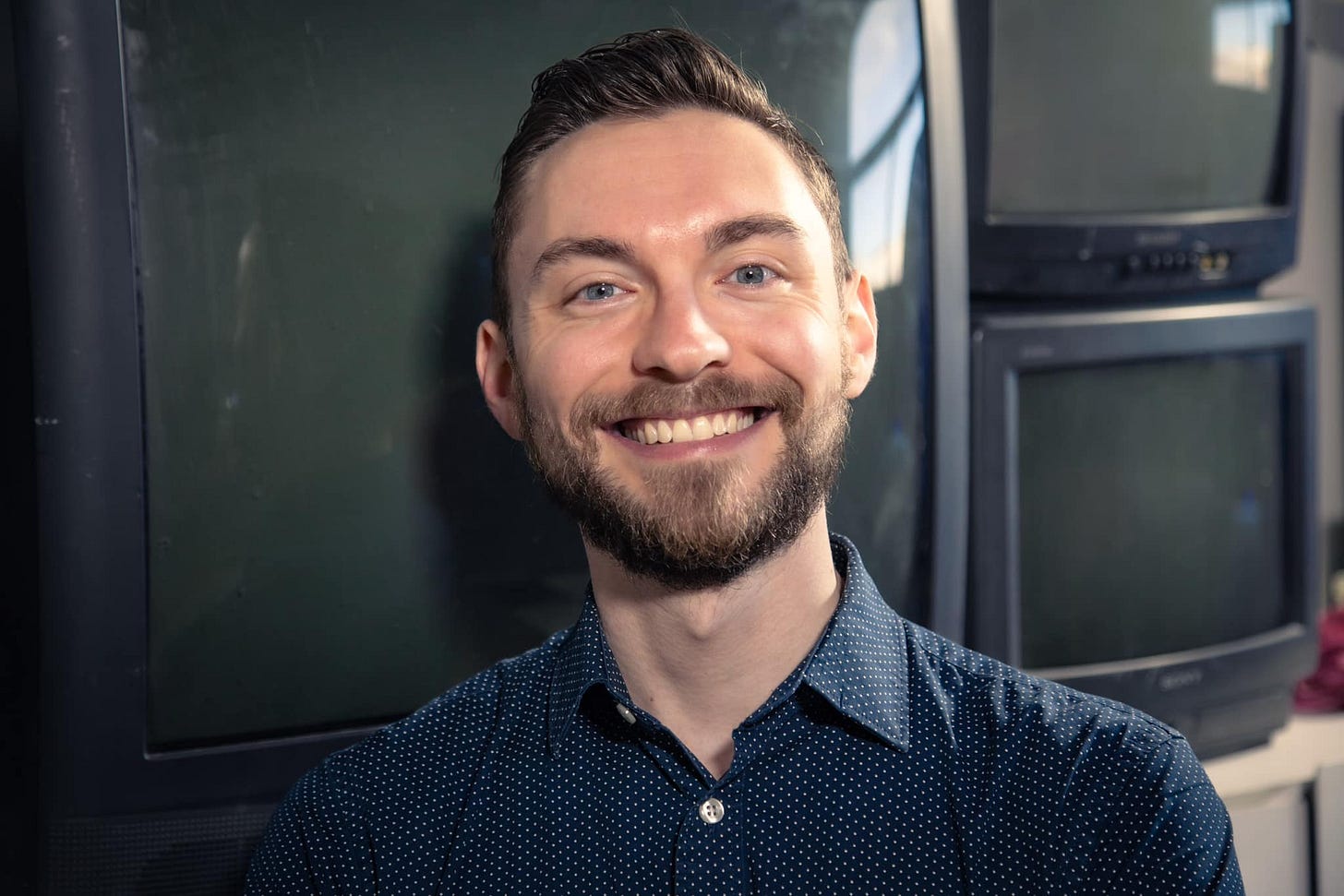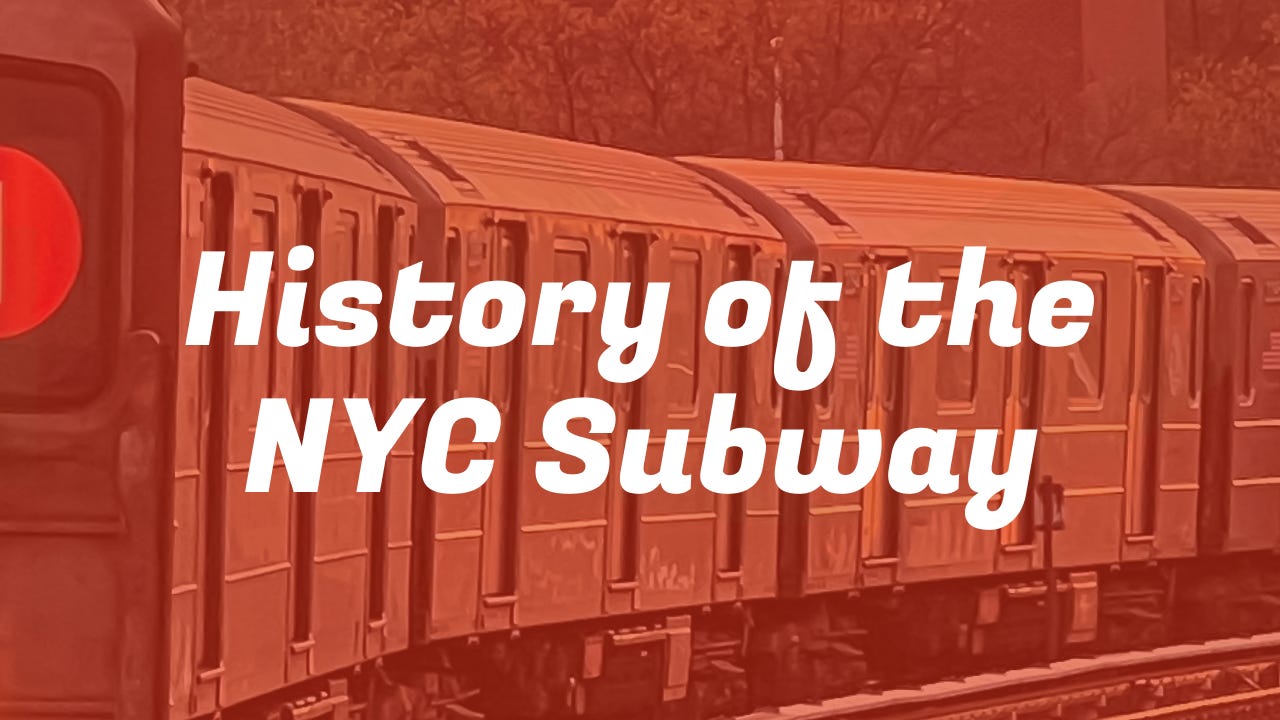History of the New York City Subway
Applications for The History of the New York City Subway, running January—March 2025, are now open until December 30! Apply here. This class explores the legal and historical origins of the subway, and the path dependencies that shape it then and now. See the full semester announcement, including other classes, here.
Content
Application overview
What you will know how to do, and have done, by the end of the class
General class structure and information
Class expectations and etiquette
About your instructor
Class syllabus
Application Overview
Applications are open from December 2 until December 30 (5pm EST). Applications will be accepted on a rolling basis, and sooner is definitely better.
I’ll inform all applicants of their status, successful or not, by January 1 or sooner. I aim to answer each application within a week of its submission, although historically it can take a few days longer. If you have not heard back from me by then, feel free to shoot me an email: daniel@maximumnewyork.com.
Time: 12:30-2:00pm, Sunday, January 5—March 2 (9 weeks, no class February 9)
Location: near the Metropolitan/Lorimer L stop
Prerequisites: None
Completion reqs: final sit-down exam, all homework, no more than two absences
Tuition: $300. Pay $150 if you need a discount, and $500 if you can afford to.
What you will know how to do, and have done, by the end of the class
Tell the story of the first subway, including the challenges to building it.
Differentiate between the IRT, BMT, and IND subway lines—and understand why they might or might not be relevant to know today!
Draw a timeline of subway and mass transit development in New York City from post-Civil War to the modern day. This will include important political developments in New York City and State, like the consolidation of 1898.
Understand who, and which institutions, have controlled the subways throughout the time period above, and add them to your timeline.
Ask intelligent questions about the role of Robert Moses in New York City’s subway history.
Speculate well about the future of the subway—might there be more? How might we get them?
Distinguish between city, state, and public authority control of the subways.
Draw a basic map of the five boroughs by hand, complete with one subway line (and any associated elevated lines).
You will have read, and written an analysis of, at least one book about the subway.
General Class Structure and Information
Meeting Time & Place
Class will meet for 1.5 hours (12:30-2:00pm) on Sunday, beginning January 5 and ending March 2. Our classroom is near the Metropolitan/Lorimer L stop.
Class Structure:
Classes will be structured as seminars, not lectures. In the first meeting of each class, I will review the overall subway timeline, and students will be the peanut gallery (it’s open season on questions and comments). We will repeat this exercise in various forms, including competitive ones, in each meeting.
There will be breaks about every 30 minutes. Eat snacks and do what you need to do then. And since class will be in the winter, and people will be coming in from the cold: please make sure to blow your nose and clear out sniffles before class, and as needed.
Attendance:
You cannot miss more than two of the eight class sessions. But if something comes up, just let me know and we can improvise.
If you are going to be late to class, you will need to text or email me with your approximate ETA. Don’t feel embarrassed or squirrely about being late, just let me know so I can conduct class accordingly.
Class Preparation & Homework:
There will be readings for each class, small class projects, and a final exam that is graded pass/fail. Plan to allocate at least 1-2 hours a week for this work. Final exams will be taken during your last class. If you fail the exam, you fail the class—but you can retake it once. You must earn 90% or above to pass.
You will be required to visit subway stations (and subway-related landmarks) and take pictures/surveys. One cannot simply study the subway’s history in a classroom—one must ride the rails, and see the stations with fresh eyes. You will have to take at least one trip a week. A few trips will require you to ride a line from one terminus to the other; these are best done with friends.
Pre-class quizzes. You will have to complete an online quiz before each class that reviews all material we’ve covered in class up to that point. You must get 100% on it, but you may retake it as many times as you need.
Book report and analysis. You will have read, and written an analysis of, at least one book about the subway. I will provide short a list for you to select from. This report will be due before the last class.
Join the Maximum New York Discord. Class participants will be added to a Maximum New York Discord server, which will be our primary mode of communication for coursework, office hours, and general discussion. There will be a code of conduct you need to accept to join the Discord, similar to the class expectations and etiquette outlined in the next section.
Class Expectations & Etiquette
Note: This class will be far easier if you have previously taken The Foundations of New York City, or are taking it concurrently. But the two can stand separately.
This class is open to anyone interested in improving the capacity of NYC’s government, with an end toward making NYC larger, more wealthy (both absolutely and per capita), more opportunity-rich, and more enjoyable for everyone. Maybe you want to get deeply involved in politics. Maybe you’re just intellectually curious. Maybe you’re somewhere in between. You’re welcome in any case.
The classroom environment I encourage is one of exploration, curiosity, playfulness, and charity/tolerance; if you have dug-in political ideas, you need to let those go, at least for the duration of the class. We are here to learn how things work first and foremost, although larger questions of political philosophy absolutely come into play at various points. You should think about politics as a systems problem with no perfect solutions, but still plenty of good ones.
This class has four formal rules of etiquette that you must follow:
Politics is a good word, and a potentially beautiful thing. We are here to learn how to do government as friends, in a chill fashion, even while dealing with weighty issues.
No bullshitting, aka be concrete. We’re here to learn together, but we’re doing it in a rigorous fashion. You must always strive to deeply understand the reality of governance that underpins your political thought.
Extend grace to everyone. We’re here to learn together. Government and politics are complicated fields, and no one knows everything. We will be better, together.
Find the good time. Taking things seriously does not mean being mad about them. The wider world can pressure people to get mad to prove that they take political ideas seriously. I do not equate anger with either sophistication or dedication, so I relieve you of that burden. Make jokes, be serious, push back, learn a lot. But give yourself (and others) a break while you’re in class.
About Your Instructor
Hello, my name is Daniel Golliher (goll- as in the gall, the nerve, and the audacity; iher- as in how they say “your” where I come from: Gol-yer). I’ve lived in New York City for six years. Besides my writing on this website, you can learn more about me on Twitter, LinkedIn, and my personal blog. I’ve written a few books, play the piano and sax, enjoy all manner of physical fitness, and can’t wait to meet you.
When it comes to understanding government and law, my default response is to simply exert maximum effort.
I graduated from Harvard College in 2014 with a degree in Government1, and since then I’ve worked in the legal industry, a coffee shop, higher ed, the legal industry again, and now I dedicate my time to Maximum New York.

Class Syllabus
The following is a general outline of subjects and resources that we will cover in class. Additions and subtractions will be made according to student interest and competency.
Themes we will cover in class, in rough order:
Crash course in city and state government, their interrelationship, and their co-evolution over time.
The long nineteenth century: how legal constraints in city and state government, and cultural-political constraints like Tammany Hall, created the conditions for public-private partnerships and public authorities.
The first subway: built between 1900-1904. We will take our time to really understand the origin of the system. The technology that enabled the subway.
The war for the subway: from 1904 through 1940, when the system was built out, and ultimately taken over by the city government.
The post-war years through The Fall of the Subway: how the subway deteriorated from 1940 through the 1980s, and what caused the system’s comeback.
Institutional evolution: the Board of Rapid Transit Commissioners, the Public Service Commission, the NYCTA, the MTA, and more.
The modern era: who runs the subway, how well is it run, and what is its future? Current events, like signal modernization, the IBX, and congestion pricing.
Examples of resources we will pull from:
Rapid Transit in New York City and in Other Great Cities. United States: Blumenberg Press, 1905.
Report of the Board of Rapid Transit Railroad Commissioners for the City of New York: Accompanied by Reports of the Chief Engineer and of the Auditor. United States: Press of W.P. Mitchell & sons, 1904 and subsequent editions.
Radford, Gail. The Rise of the Public Authority: Statebuilding and Economic Development in Twentieth-Century America. United Kingdom: University of Chicago Press, 2013.
Morris, John E. Subway: The Curiosities, Secrets, and Unofficial History of the New York City Transit System. New York: Black Dog & Leventhal Publishers, 2020.
The Elevated Railroad Cases: Private Property and Mass Transit in Gilded Age New York in the NYU Annual Survey of American Law, April 2006.
Caro, Robert A. The Power Broker. New York: Knopf Doubleday Publishing Group, 1974.
Ascher, Kate., Marech, Wendy. The Works: Anatomy of a City. United Kingdom: Penguin Publishing Group, 2007.
Gelinas, Nicole. Movement: New York's Long War to Take Back Its Streets from the Car. United States: Fordham University Press, 2024.
“Political Science Degrees Must End” (Golliher, 2023)

